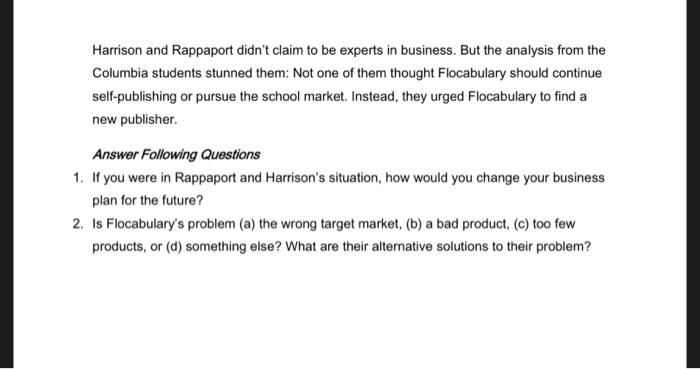Question
Small Business Management 2520-51 Case Study #1 The Business Plan: Chapter Closing Case Memory by Music Blake Harrison was a good student in high



Small Business Management 2520-51 Case Study #1 The Business Plan: Chapter Closing Case Memory by Music Blake Harrison was a good student in high school, but he struggled to memorize facts for tests. He had no problem knowing all the lyrics to his favorite rap songs, but when it came to academics, forget it-literally. It was then that he realized that if a rapper hip- hopped things like vocabulary words, students like him would score better on the SAT exam. Harrison earned a degree in English from the University of Pennsylvania and headed to San Francisco where he met Alex Rappaport. Rappaport had graduated from Tufts with a degree in music and was trying to break into the business by writing tracks for indie films and TV commercials. One evening, Harrison told his friend about his idea for using hip-hop to help students. Rappa-port said, "let's do it." They wrote and recorded two songs that together defined 80 SAT vocabulary words, using lyrics like: "They don't say the word think, they say ratiocinate/They don't render repeat, they say recapitulate." They sent demos to various educational publishers and knew they were on to something when study guide publisher SparkNotes commissioned two songs and showcased both songs as free, streamable MP3S on its Web site. Harrison and Rappaport invested their life savings into their new company, Flocabulary. They launched a Web site and began selling a self-published hip-hop guide to the SAT. For two years, the pair hustled to make their start-up work, but sales were hard to close and they were nearly out of money. In the spring of 2007, Harrison and Rappa-port were working the International Reading Conference in Toronto. They were desperate to close some deals. "Wanna hear about how to teach history through hip-hop?" they beckoned across the aisles. An attendee wandered over, and Harrison and Rappaport cued up "Let Freedom Ring," one of their fact-filled rap songs, an ode to Martin Luther King Jr.'s "I Have a Dream" speech. The educator listened intently to their pitch. He picked up a copy of their book, Hip Hop U.S. History, and flipped through the pages, nodding his head in approval. Then it happened again. "You kids have a million-dollar idea here," the man told them. And then he walked away. It seemed like they always walked away. Educators walking away from their product just didn't make sense. Most of the teachers and administrators they talked to seemed genuinely interested in their product. Time after time, they would listen to the pitch and rave about the concept-but more often than not would leave the booth with just one $18 book, or worse, an earful of praise. Harrison wondered, if Flocabulary's idea was so great and the materials so impressive, why weren't people buying? The two friends wondered if they were cut out to run a business at all. In April 2006, Flocabulary: The Hip-Hop Approach to SAT Vocabulary hit bookshelves worldwide thanks to a deal with Cider Mill Press, a novelty book publisher in Kennebunkport, Maine. "I thought that with our design sensibilities and publishing experience, we could really make this a commercially viable product," says John Whalen, founder of Cider Mill. The best part: Cider Mill worked with Sterling Publishers, the distribution arm of Barnes & Noble, which meant Flocabulary's books would find space in bookstores nationwide. The Hip Hop Approach to SAT Vocabulary sold 10,000 copies in its first year and has since been reprinted five times. And Flocabulary received a slew of attention from media outlets, such as CNN, DailyCandy, MTV, and NPR- even historian Howard Zinn offered praise. So Flocabulary guides began to sell due to distribution outlets, but the partners decided that students taking the SAT or shopping at Barnes & Noble were not the ones who could benefit from their approach the most. They decided to transform Flocabulary into an actual publishing business. They raised about $50,000 from friends and family and began visiting schools and attending education conferences. But just as when they first started, educators were a tough sell. "Teachers would say, "This is so cool; my kids will love this!' but would buy just one book," Rappaport recalls. They decided to participate in a program at Columbia Business School that pairs new business owners with MBA students who analyze business plans and offer advice. Harrison and Rappaport didn't claim to be experts in business. But the analysis from the Columbia students stunned them: Not one of them thought Flocabulary should continue self-publishing or pursue the school market. Instead, they urged Flocabulary to find a new publisher. Answer Following Questions 1. If you were in Rappaport and Harrison's situation, how would you change your business plan for the future? 2. Is Flocabulary's problem (a) the wrong target market, (b) a bad product, (c) too few products, or (d) something else? What are their alternative solutions to their problem?
Step by Step Solution
3.46 Rating (127 Votes )
There are 3 Steps involved in it
Step: 1
Answer 1 In this case I would definitely modify the business plan for the future by focusing mainly ...
Get Instant Access with AI-Powered Solutions
See step-by-step solutions with expert insights and AI powered tools for academic success
Step: 2

Step: 3

Ace Your Homework with AI
Get the answers you need in no time with our AI-driven, step-by-step assistance
Get Started


